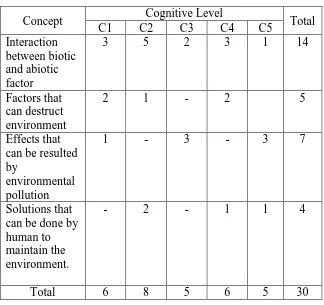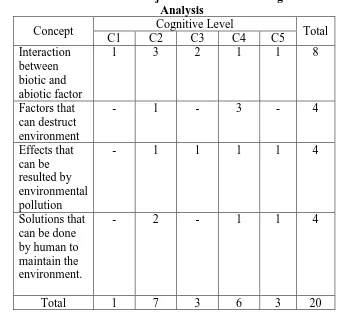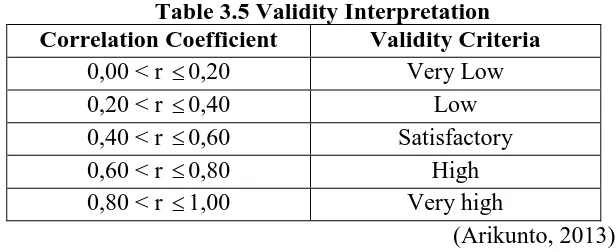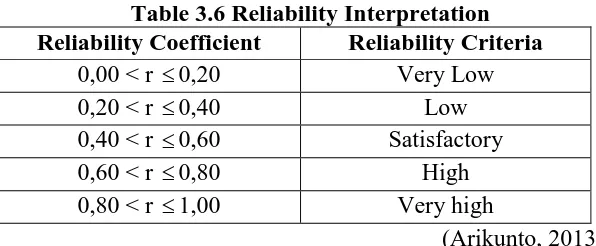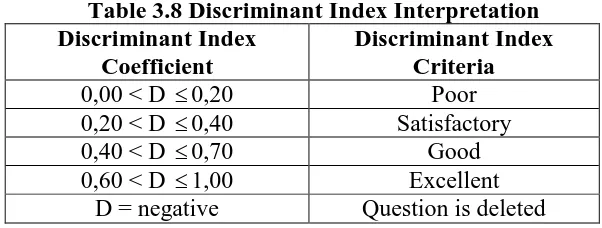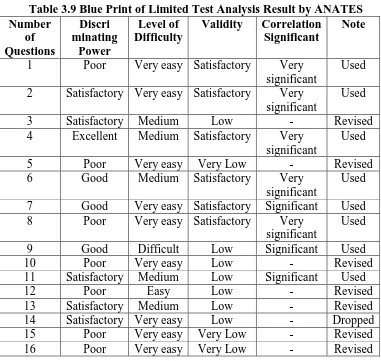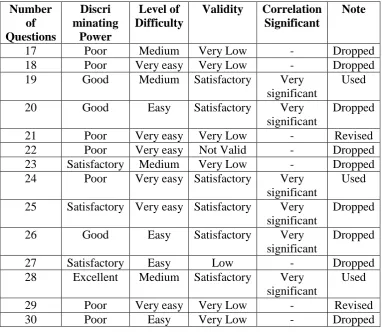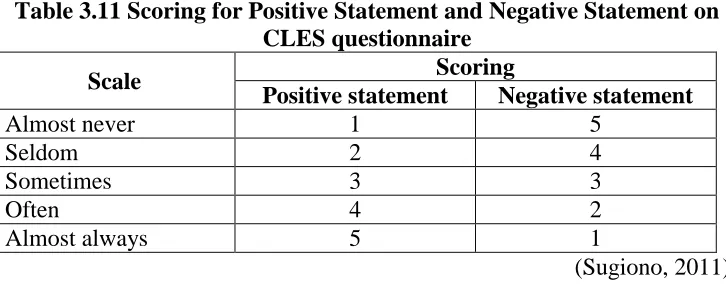THE PROFILE OF LEARNING ENVIRONMENT AND
COGNITIVE ABILITY OF STUDENTS IN LEARNING
ENVIRONMENTAL POLLUTION BY DISCUSSION
AT SEKOLAH INDONESIA KUALA LUMPUR
RESEARCH PAPER
Submitted as Requirement to Obtain Degree of Sarjana Pendidikan in
International Program on Science Education (IPSE)
Arranged by:
Hanifah Mulyani
1100342
INTERNATIONAL PROGRAM ON SCIENCE EDUCATION
FACULTY OF MATHEMATICS AND SCIENCE EDUCATION
UNIVERSITAS PENDIDIKAN INDONESIA
THE PROFILE OF LEARNING ENVIRONMENT AND
COGNITIVE ABILITY OF STUDENTS IN LEARNING
ENVIRONMENTAL POLLUTION BY DISCUSSION
AT SEKOLAH INDONESIA KUALA LUMPUR
Oleh
Hanifah Mulyani
Sebuah skripsi yang diajukan untuk memenuhi salah satu syarat memperoleh gelar Sarjana Pendidikan di Fakultas Pendidikan Matematika dan
Ilmu Pengetahuan Alam
© Hanifah Mulyani 2015
Universitas Pendidikan Indonesia
Agustus 2015
Hak Cipta dilindungi undang-undang.
Skripsi ini tidak boleh diperbanyak seluruhnya atau sebagian,
SHEET OF LEGITIMATION
THE PROFILE OF LEARNING ENVIRONMENT AND
COGNITIVE ABILITY OF STUDENTS IN LEARNING
ENVIRONMENTAL POLLUTION BY DISCUSSION
AT SEKOLAH INDONESIA KUALA LUMPUR
By :
Hanifah Mulyani
1100342
Approved and Authorized by,
Supervisor I,
Dr. Diana Rochintaniawati, M.Ed. NIP. 196709191991032001
Supervisor II,
Rika Rafikah Agustin, M.Pd. NIP.198308032011211001
Perceive,
Head of International Program on Science Education Study Program
THE PROFILE OF LEARNING ENVIRONMENT AND
COGNITIVE ABILITY OF STUDENTS IN LEARNING
ENVIRONMENTAL POLLUTION BY DISCUSSION
AT SEKOLAH INDONESIA KUALA LUMPUR
Hanifah Mulyani
International Program on Science Education
ABSTRACT
The purpose of this research is to analyze learning environment and cognitive ability of students who experience discussion in learning environmental pollution at Sekolah Indonesia Kuala Lumpur (SIKL). Furthermore, this research is purposed to analyze the factors influencing students’ discussion process at SIKL. This research using descriptive method to describe the current condition of discussion followed by 24 students in 7 grade as the sample. The data in this research is gained through pre-test and post-test score, questionnaire based on CLES, and students’ interview. According to result of this research, learning environment created through discussion activities affects to cognitive ability of students at SIKL. Learning activities are affected by factors such as students’ prior knowledge, learning style of students, conformity, gender differences, students’ personal intelligence and students’ interests. Moreover, this research suggest teacher who apply discussion method to consider above factors. Teacher has to be eager to pack discussion become more interesting and valuable to make students feel a joyful athmosphere in learning.
PROFIL LINGKUNGAN PEMBELAJARAN DAN KEMAMPUAN
KOGNITIF SISWA DALAM MEMPELAJARI POLUSI
LINGKUNGAN DENGAN METODE DISKUSI DI
SEKOLAH INDONESIA KUALA LUMPUR
Hanifah Mulyani
International Program on Science Education
ABSTRAK
Tujuan dari penelitian ini adalah untuk menganalisis lingkungan pembelajaran dan kemampuan kognitif siswa yang meggunakan metode diskusi dalam mempelajari polusi lingkungan di Sekolah Indonesia Kuala Lumpur (SIKL). Selain itu, penelitian ini pun bertujuan untuk menganalisis faktor-fator yang mempengaruhi proses diskusi siswa di SIKL. Penelitian ini menggunakan metode deskriptif untuk menggambarkan kondisi riil ketika diskusi dilaksanakan oleh 24 siswa dari kelas 7 yang dipilih sebagai sampel. Data dalam penelitian ini didapat dari skor pre-test dan post-test, kuisioner berdasar pada CLES, dan wawancara siswa. Berdasarkan hasil penelitian ini, lingkungan pembelajaran melalui diskusi mempengaruhi kemampuan kognitif siswa. Aktivitas-aktivitas pembelajaran dipengaruhi oleh beberapa fator seperti prior knowledge siswa, gaya belajar siswa, kenyamanan, perbedaan gender, intelegensi siswa, dan minat siswa. Selebihnya, penelitian ini menyarankan guru yang mengaplikasikan metode diskusi untuk mempertimbangkan faktor-faktor tersebut. Guru haruslah berkeinginan untuk menciptakan diskusi yag lebih menarik dan berarti untu membuat mereka merasakan atmosfer belajar yang lebih menyenangkan.
CONTENT
Page
SHEET OF LEGITIMATION ... i
DECLARATION ... ii
ABSTRACT ... iii
PREFACE ... iv
ACKNOWLEDGEMENT ... v
CONTENTS ... vii
LIST OF TABLES ... x
LIST OF FIGURES ... xii
LIST OF APPENDICES ... xiii
CHAPTER I INTRODUCTION A. Background ... 1
B. Research Problem ... 4
C. Research Question ... 4
D. Limitation of Problem ... 4
E. Research Objective ... 5
F. Research Benefit ... 5
CHAPTER II LITERATURE REVIEW A. Constructivism in Learning ... 7
B. Learning Strategy ... 8
C. Learning Method ... 8
D. Implementation of Discussion in Learning ... 9
1. Discussion as A Teaching Method in Learning ... 9
2. An Effective Discussion in Learning ... 10
3. The Factors Influencing Discussion ... 11
E. Learning Environment ... 14
2. Assessing Learning Environment ... 14
3. Learning Environment Based on Constructivism Learning Environment Survey ... 15
F. Cognitive Ability of Students ... 17
G. Topic of Environmental Pollution ... 18
1. Environmental Pollution Chapter on National Curriculum of 2013 ... 18
2. Causes of Environmental Pollution ... 19
3. Effects of Environmental Pollution ... 22
4. Solutions of Environmental Pollution ... 24
H. Relevant Research ... 26
CHAPTER III RESEARCH METHODOLOGY A. Research Method and Research Design ... 27
1. Research Method ... 27
2. Research Design ... 27
B. Population and Sample ... 27
C. Operational Definition ... 28
D. Research Instrument ... 29
1. Questionnaire ... 29
2. Cognitive Paper Test ... 29
3. Interview Sheet ... 31
E. Instrument Analysis ... 32
1. Validity ... 32
2. Reliability ... 33
3. Level of Difficulty ... 34
4. Discriminating Power ... 34
5. Distractor ... 35
F. Data Collecting ... 37
G. Data Analysis Technique ... 37
H. Research Procedure ... 38
CHAPTER IV RESULT AND DISCUSSION
A. Result ... 42
1. Learning Environment ... 42
2. Cognitive Ability of Students ... 50
B. Discussion ... 53
CHAPTER V CONCLUSION AND RECOMMENDATION A. Conclusion ... 68
B. Recommendation ... 69
REFERENCE ... 71
APPENDICES ... 75
LIST OF TABLES
Page
Table 2.1 The Classification of Agreement Level Average Score ... 16
Table 3.1 Blue Print of Questionnaire Based on CLES ... 29
Table 3.2 Blue Print of Cognitive Paper Test Question ... 30
Table 3.3 Blue Print of Objective Test after Passing Instrument Analysis ... 31
Table 3.4 Blue Print of Interview Sheet ... 32
Table 3.5 Validity Interpretation ... 33
Table 3.6 Reliability Interpretation ... 34
Table 3.7 Difficulty Index Interpretation ... 34
Table 3.8 Discriminant Index Interpretation ... 35
Table 3.9 Blue Print of Limited Test Analysis Result by ANATES ... 36
Table 3.10 The Blue Print of Collecting Data ... 37
Table 3.11 Scoring for Positive Statement and Negative Statement on CLES Questionnaire ... 38
Table 3.12 The Classification of Agreement Level Average Score ... 38
Table 3.13 Data Taking Timeline of Discussion Implementation ... 40
Table 4.1 The Distribution of Students’ Personal Relevance Agreement Level ... 42
Table 4.2 The Distribution of Students’ Uncertainty Agreement Level ... 44
Table 4.3 The Distribution of Students’ Critical Voice Agreement Level ... 46
Table 4.4 The Distribution of Students’ Shared Control Agreement Level ... 47
Agreement Level ... 49
Table 4.6 The Frequency Distribution of Students’ Pre-test Score ... 51
Table 4.7 The Frequency Distribution of Students’ Post-test Score ... 51
Table 4.8 The Distribution of Gain Score of Students ... 52
LIST OF FIGURES
Page
Figure 2.1 The Concentration of Greenhouse Gases until 2005 ... 22
Figure 3.1 Research Scheme ... 41
Figure 4.1 Percentage of Students’ Personal Relevance Agreement Level ... 43
Figure 4.2 Percentage of Students’ Uncertainty Agreement Level ... 45
Figure 4.3 Percentage of Students’ Critical Voice Agreement Level ... 46
Figure 4.4 Percentage of Students’ Shared Control Agreement Level ... 48
Figure 4.5 Percentage of Students’ Negotiation Agreement Level ... 50
LIST OF APPENDICES
Page
A. INSTRUCTIONAL TOOL
Appendix A.1 Lesson Plan... 75
Appendix A.2 Environmental Pollution Video Screenshoot ... 84
B. RESEARCH INSTRUMENT
Appendix B.1 Screenshoot of Instrument Judgement ... 88
Appendix B.2 Instrument of Cognitive Paper-Test
before Validation Test ... 89
Appendix B.3 Instrument of Cognitive Paper-Test
after Validation ... 101
Appendix B.4 Instrument of Constructvism Learning
Environment Survey (CLES) ... 109
Appendix B.5 Instrument of Students’ Interview ... 113
C. RESULTS OF RESEARCH DATA
Appendix C.1 Data Processing of Cognitive Ability of Students ... 114
Appendix C.2 Data Processing of Classroom Learning
Environment Survey (CLES) ... 121
Appendix C.3 Data of Students’ Interview Results ... 124
D. DOCUMENTATION
CHAPTER I
INTRODUCTION
A. Background
Constructivism in learning concerns on facilitating students to be more
active in classroom to gain the knowledge (Jacobsen, Eggen, and Kauchak,
2009). Constructivism in learning provides students an active learning where
they are involved in solving problem, working in small group, participating
on collaborative learning, taking investigative work, and having experiental
learning. It is significantly different comparing activities in constructivism
learning with passive learning activities. Passive learning activities only
enacting students as information receiver and evolving them as a very loyal
listener to the teacher. That is why nowadays, constructivism in learning is
being focused by teachers to improve the quality of learning activities in
classroom. Therefore, students will not be passive learner anymore but they
are triggered to have more interactions. Teachers try to stimulate students in
gaining knowledge by themselves through such activities they create in the
classroom.
Regarding to the implementation of constructivism in learning, different
learning environment might be created as teacher creatively willing to
construct the best learning activity which suit student needs and learning
objectives. Based on Fraser (1986), valuable goal of school intrinsically
begun at having constructivism learning environments. Having a positive
classroom environment is an educationally desirable end in its own right.
Nature of learning environment has a potent influence on how well students
achieve a range of desired educational outcomes. Cognitive ability of students
is one of educational outcomes that should be achieved by teacher. As the
final consideration, learning environment is desirably noted as a potent
influence towards cognitive ability of student itself.
Teachers can have constructivism in learning through some learning
2
on an expanding body of strategies and methods that will enable them to
create more positive and supportive learning environment (Jones and Jones,
1994). An effective teacher using different learning strategies to help students
reach the goals which previously composed in instruction planning (Jacobsen,
Eggen, and Kauchak, 2009). Teachers apply student-centered learning
strategy to facilitate them constructing their own knowledge. Students are
given more responsibility to seek what they need to know when they gaining
their knowledge (Jacobsen, Eggen, and Kauchak, 2009). This teachers’ effort
have been relevant with constructivism in learning theory. After that, teachers
need to apply teaching method which support student-centered learning
strategy. According to Rahman et al. (2011), teaching method could be
occured simultanously or in a sequence in the proper ways. Teachers have to
consider a teaching method which suit both the concepts and the students in
order to achieve the goal of learning.
One of method that has emerged constructivism in learning is discussion
method. It is also usually conducted in the classroom. Sometimes, teachers
want to have an independent learning activity for students which can increase
their cognitive ability. Then, instructing students to have a discussion with
their peers is decided. Bennett et al. (2004) stated that discussion has been
strongly advocated as an important teaching approach for a number of years,
partly arising from a more general movement towards student-centered
learning. It is seen as a very important method to provide students an
opportunity to articulate and reflect on their own ideas about scientific
phenomena. Discussion method has great potential for classroom teaching
because it implies open and active participation of students (Gall and Gillet,
2001). Even, teacher can vary its use to achieve several different instructional
purposes.
Students in Sekolah Indonesia Kuala Lumpur (SIKL) come from various
cities in Indonesia. They are very different in attitude and cultures. Most of
them coming from high-economic level families with high education. That is
3
currently have their own perspective and have their own way to strengthen it.
In learning activities, students’ characteristics are shown, especially when discussion is applied by teacher. In this school, discussion is a method which
used to be implemented by teacher.
Discussion is a process whereby two or more people express, clarify and
pool their knowledge, experiences, opinions, and feelings (Rahman et al.,
2011). Discussion is neither interview nor talking with persons, yet it is an
activity in which students collect the data and information sistematically to
achieve their current purposes (Irwanto, 2006). In every day conversation, the
term discussion could be a talk about anything, but actually discussion is
considered to be a serious and systematic talk about a specific topic.
Discussion is task-oriented that’s why it is held to achieve a common purpose
or a goal of a group.
Looking at those experts’ statement, it is clarified that discussion will
provide students such activities in learning. Students are allowed to express
their opinions, argue some statements, ask questions, and negotiate other
responses. Moreover, students might have conflict with others when they
discuss some problems. Nevertheless, they are expected to respect other
opinions, be calm and be patient when someone pose some arguments which
contradict with theirs. Students have to obey all of rules in discussion, unless
they distract discussion itself. Therefore, in discussion, good interaction
among members will lead to the achievement of current purposes.
Discussion which is held by teacher will create its learning environment
in the classroom. Students who used to have discussion in learning activities
might have such an effect of this activity, for example cognitive ability. As
some experts claims that learning environment will influence desired
educational outcomes, then paying much attention to learning environment
and cognitive ability of students is urgently needed. Therefore, a research
which present a current profile of learning environment and cognitive ability
of students by using discussion method at Sekolah Indonesia Kuala Lumpur
4
B. Research Problem
The research problem of this study is “How is The Profile of Learning Environment and Cognitive Ability of Students in Learning Environmental
Pollution by Discussion at Sekolah Indonesia Kuala Lumpur?”
C. Research Question
Elaborating the research problem, the research attempts to explore these
following questions:
1. How is the profile of learning environment when students learn
environmental pollution by discussion at Sekolah Indonesia Kuala
Lumpur?
2. How is the profile of cognitive ability of students in learning
environmental pollution by discussion at Sekolah Indonesia Kuala
Lumpur?
3. What are factors that influence students’ discussion process when they
learn environmental pollution by discussion at Sekolah Indonesia Kuala
Lumpur?
D. Limitation of Problem
In order to make the research become more focused, the problem is
limited as follow:
1. Learning activity that is done in this reseach is discussion.
2. Cognitive ability of students that is described in this research is starting
from C1 (remembering) until C5 (evaluating), based on Anderson et al.
(2001).
3. Learning environment that is described in this research is based on
Constructivism Learning Environment Survey developed by Taylor,
Fraser, & White (1994). It consists of five aspects such as personal
relevance, uncertainty, critical voice, shared control, and student
5
E. Research Objectives
This research has objectives as follow;
1. To analyze the profile of learning environment when students learn
environmental pollution by discussion at Sekolah Indonesia Kuala
Lumpur.
2. To analyze the profile of cognitive ability of students in learning
environmental pollution by discussion at Sekolah Indonesia Kuala
Lumpur.
3. To analyze aspects that influence students’ discussion process in learning
environmental pollution by discussion at Sekolah Indonesia Kuala
Lumpur.
F. Research Benefits
The results of this research are expected to provide benefits as follow:
1. For teachers, this research will provide them the descriptions of learning
environment which are created when teacher implements discussion in
the classroom. Other than that, the result of this research will give
another informations how discussion implementation might affect to
cognitive ability of students at Sekolah Indonesia Kuala Lumpur. Thus,
teachers’ perspective on discussion implementation in learning would be
explored reasonably based on results of this research.
2. For students, this research will provide them such an independent
learning activity called discussion. Through this activity, students will try
to actively build their own knowledge toward environmental pollution
issues and discuss those issues with their member of group in discussion.
These activities are expected not only to give students different
athmosphere in learning but also to avoid such a boredom in the
classroom where students is just being passive learner who always listen
teacher explanations. Discussion might let students to have conflict
6
hand, discussion might let students to have a good teamwork to
accomplish their own goal.
3. For another researcher, this research will be references to develop
another kind of research which involve discussion as the focus of
research. The informations which are appeared through this research
could be evaluated as the way to have more better ideas for the future
impactful research. Hopefully, in the future, more researches that are
conducted by other reseachers will give valuable influences for better
CHAPTER III
RESEARCH METHODOLOGY
A. Research Method and Research Design
1. Research Method
The research has a purpose to describe the current condition of
learning environment and cognitive ability of students when discussion is
implemented in teaching learning activities. According to this, then
descriptive method is used to fulfill the aim of research itself. In the
descriptive, the main objective is to give a very accurate portrayal of
characteristics of persons, situations, or groups (Polit & Hungler, 2004).
Thus, in this research, the object of research is not given any treatment
and natural condition is set without any manipulation. It will provide
reasonable answer why something is occured (Arikunto, 2010).
2. Research Design
Non-experimental with natural descriptive design is used in this
research. All of students come from two classes of seventh grade are
given pre-test and post-test. Those score are captured as the data of
cogitive ability of students. After that, Classroom Learning Environment
Survey (CLES) is a questionnaire given to the students after the
instruction is done. The result of this questionnaire is also taken as the
data of learning environment. The last, interview is conducted to clarify
all of results which are gained in this research. Based on those results, the
profile of learning environment and cognitive ability of students could be
identified.
B. Population and Sample
The location of this research is Sekolah Indonesia Kuala Lumpur (SIKL)
Malaysia which uses National Curriculum of 2013. The instruction in classes
29
The population of this research is all students in SIKL. The sample are
7-1 class which consist of 7-17-1 students and 7-2 class which consist of 7-13
students. So, the number of all students is 24 students. All of students in both
classes experience discussion in learning environmental pollution as it is the
main focus of this research. The subject of this research is defined under
purposed of class which used to implement discussion in teaching learning
activities.
C. Operational Definition
In order to avoid misconception, some operational definitions are
explained in this research. Those terminologies are explained as follow:
a. Learning activity in both classes is discussion which refers to statement
of Discussion is a process whereby two or more people express, clarify
and pool their knowledge, experiences, opinions, and feelings to achieve
their current purposes (Rahman et al., 2011). In this research, students
gather with three until four friends and they try to solve problem about
environmental pollution given by the teacher. Discussion is intended as
the way to look cognitive ability of students. Therefore, post-test is done
in the end of discussion to evaluate this aspect.
b. Cognitive ability of students in this research includes level of
remembering (C1), understanding (C2), applying (C3), analyzing (C4),
and evaluating (C5) based on Anderson et al. (2001). Data of cognitive
ability itself are gained by giving cognitive paper test to students in the
form of multiple choice questions.
c. Classroom learning environment in this research refers to Constructivist
Learning Environment Survey (CLES) which has been developed by
Taylor and Fraser (1991). CLES consists of five aspects such as personal
relevance, uncertainty, critical voice, shared control, and student
30
by quistionnaire. Data obtained through questionnaire is adjusted with
CLES aspects.
D. Research Instrument
In this research, instrument is necessary to be used for gaining data.
There are three types instruments that are used in this research. Those
instruments are described below:
a. Questionnaire
Questionnaire is an instrument which is distributed to the students to
investigate and describe the classroom learning environment after teacher
conducting instruction. Questionnaire used is based on Classroom
Learning Environment Survey format which was developed by Taylor
and Fraser (1991). This questionnaire results the students’ perception
about how the teaching learning process going on and finally give the
description about classroom learning environment. There are five
indicators which is measured in this questionnaire. Questionnaire consists
of 30 statements, 28 are positive statements while 2 are negative
statements. The blueprint of questionnaire based on CLES is shown
below on Table 3.1.
Table 3.1 Blue Print of Questionnaire Based on CLES
Indicators Question’ number
Personal Relevance 1,2,3,4,5,6
Uncertainty 7,8,9,10,11,12
Critical Voice 13,14,15,16,17,18 Shared Control 19,20,21,22,23,24 Student Negotiation 25,26,27,28,29,30
b. Cognitive Paper Test
Cognitive paper test is conducted to describe cognitive ability of
students in mastering the concept. Cognitive paper test consists of two
sections such as pre-test and post-test. Pre-test is given to students before
31
the students after teacher conducting instruction in classroom. Pre-test is
intended to know students’ prior knowledge about the concept of
environmental pollution. Post-test is conducted in the end of teaching
learning process. It is intended to know whether the improvement of
students’ cognitive is gained after teacher conducting instruction or not.
This cognitive paper test is given in the form of multiple choice question.
Multiple choice question consists cognitive domain from C1 until C5
which is about knowledge, comprehension, application, analysis, and
evaluation (Anderson et al., 2001). Cognitive paper test firstly consists of
30 questions after passing judgement by expert. It is used to look students’ cognitive starting from C1 until C5. Then, it is distributed to students in grade 8 as a limited test. The blueprint of instrument before
passing instrument analysis step is described in Table 3.2 below.
Table 3.2 Blue Print of Cognitive Paper Test Question
Concept Cognitive Level Total
32
The next step after conducting limited test to 8 grade students is
analyzing this objective test using ANATES. Based on this analysis, 10
questions are used directly and there are 10 questions which are revised.
The new blueprint of objective test is shown below on Table 3.2.
Table 3.3 Blue Print of Objective Test after Passing Instrument Analysis
Concept Cognitive Level Total
C1 C2 C3 C4 C5
statement about learning activities that have been conducted in
classroom. This interview is given to students after they finish whole
activites starting from pre-test until post-test as the end of learning
activites. Interview sheet consists of students statement how their feeling
was during learning activities. Students are asked about learning style
they like the most, the opinion about discussion, their conformity during
33
intelligence, and their interest towards science subject. The blueprint of
interview sheet are shown below on Table 3.4.
Table 3.4 Blue Print of Interview Sheet
No Question Answer
1 What is your best learning style? State your reason
2 Do you like discussion method? State your reason
3 Which one do you like. Doing discussion with similar gender or doing discussion with different gender? State your reason 4 Which one do you like. Doing
discussion with smarter friends or doing discussion with person whose achievement is not too high and not too low? State your reason
5 What is the thing you do not like when doing discussion?
6 Do you like science subject? State your reason
7 Do you like environmental pollution chapter? State your reason
8 Is your spirit in learning a subject defined first by your interest toward that subject? State your reason
E. Instrument Analysis
Instrument analysis is done by judgement expert and ANATES V4.
Cognitive paper test which is used in limited test firstly is judged by expert.
Then, limited test could be conducted. The results of limited test is analyzed
by ANATES. Aspects which are analyzed such as validation, reliability, level
of difficulty, discriminating power, and distractor which should fulfill the
criteria.
34
Based on Arikunto (2013), evaluation of instrument must be valid in
order to get a valid result of the activities conducted. Anderson in
Arikunto (2013) said that a test is valid if it measures what it purpose to
measure. The validity which is used is content validity. Content validity
measures a particular purpose which is still relevant with the
material/concept given to the students. The formula to investigate the
number of validity is product moment correlation, shown as follow
rxy : correlation coefficient between X variable and Y variable
The validity interpretation is represented below on Table 3.5.
Table 3.5 Validity Interpretation Correlation Coefficient Validity Criteria
0,00 < r 0,20 Very Low
Reliability is related with trust. A test which has a high level of trust
then usually can give a consistent result in repeated trials. It means that
the reliability of a test will be very related with the consistency of test
results itself (Arikunto, 2013).
The formula which is used to define the reliability of objective test
which is multiple question is alpha formula.
35
r11 : Instrument reliability
n : Amount of question
i2: Amount of variant score in each item2 i
: Varian total
The reliability interpretation is represented below on Table 3.6.
Table 3.6 Reliability Interpretation Reliability Coefficient Reliability Criteria
0,00 < r 0,20 Very Low
Difficulty index is usually used as the number to show the difficulty level
of question. The range of level of difficulty is from 0,00 to 1,00. The
lower the index, then the more difficult the question and vice versa.
The formula that is used to measure the level of difficulty ( difficulty
index), shown as follow.
P : Difficulty index
B : Number of students who answer the question correctly JS : Number of all students who join the test
The difficulty index interpretation is represented below on Table 3.7.
Table 3.7. Difficulty Index Interpretation Reliability Coefficient Validity Criteria
0,00 < P < 0,30 Difficult 0,30 < P < 0,70 Middle JS
36
0,70 < P < 1,00 Easy
(Arikunto, 2013)
4. Discriminating Power
Discriminating power is an ability of question to discriminate
between high-achiever students and low-achiever students (Arikunto,
2013). Number that shows discriminating power is called as discriminant
index (D). Discriminant index range is about 0,00 to 1,00. Good
questions will have discriminant index between 0,4 and 0,7 (Arikunto,
2013).
The formula of discriminant index is
D : Discriminating Power (Discriminant Index)
A
P : Proportion of upper group who answer question correctly
B
P : Proportion of lower group who answer question correctly
P is level difficulty
The discriminant index interpretation is represented below on Table
3.8.
Table 3.8 Discriminant Index Interpretation Discriminant Index D = negative Question is deleted
37
(Arikunto, 2013)
5. Distractor
A good distractor can be defined when an option is chosen by almost
of students. Students think that the option is the best answer while it is
actually the wrong answer. Distractor which even is not chosen by students is actually bad, because it can not attract student’ mind to consider the option as the best answer (Arikunto, 2013).
Due to the result of limited test, the reliability of test is 0,81. The
average score is 22,41. The number of question which is used directly in
research is 10 and the number of question which is revised based on
analysis of ANATES is 10. The blue print of limited test analysis result
by ANATES is shown below on Table 3.9.
Table 3.9 Blue Print of Limited Test Analysis Result by ANATES Number
2 Satisfactory Very easy Satisfactory Very significant
Used
3 Satisfactory Medium Low - Revised
4 Excellent Medium Satisfactory Very significant
7 Good Very easy Satisfactory Significant Used 8 Poor Very easy Satisfactory Very
significant
Used
9 Good Difficult Low Significant Used
10 Poor Very easy Low - Revised
11 Satisfactory Medium Low Significant Used
12 Poor Easy Low - Revised
13 Satisfactory Medium Low - Revised
14 Satisfactory Very easy Low - Dropped
15 Poor Very easy Very Low - Revised
38
25 Satisfactory Very easy Satisfactory Very significant
28 Excellent Medium Satisfactory Very significant
post-test) and questionnaire based on CLES. The instrument which is used in
written test is multiple choice question while the instrument which is used to
get the profile of classroom learning environment is based on Constructivist
Learning Environment Survey (CLES). The blueprint of data collecting is
shown below on Table 3.10.
39
discussion in
instruction Students’
Interview
G. Data Analysis Technique
Data analysis is done by calculating the score of pre-test and post-test of
students. The average of pre-test and post-test score is also calculated.
Another aspects that would be described on analysis pre-test and post-test
such as the highest and the lowest score, percentage of students who pass the
average score and cognitive level achievement that is achieved by students.
Furthermore, questionnaire based on CLES’ results is analyzed by using
summated rating, which is well-known as Likert Scale. Scoring on each
aspect on CLES is based on positive statement and negative statement stated.
Scoring for positive statement and negative statement is shown below on
Table 3.11.
Table 3.11 Scoring for Positive Statement and Negative Statement on CLES questionnaire
Scale Scoring
Positive statement Negative statement
Almost never 1 5
analyzed based on the average score of agreement level. The average score of
agreement level of each student defines the agreement level of each aspect as
a whole in this research. The average of agreement level is based on this scale
on Table 3.12 below.
Table 3.12 The Classification of Agreement Level Average Score Range of
Agreement Level Average
40
three stages are preparation stage, implementation stage, and completion
stage.
1. Preparation Stage
Preparation stage of this research includes,
a. Conducting study on characteristic of school, students, teacher, and
teaching method which will be the part of the research later. This is a
very initial step to look for the problem and gain the idea which will
be taken for the research.
b. Conducting literature study. It could be taken from various resources
such as book, journals, artcles, and etc.
c. Defining and analyzing a topic for research including variable.
d. Defining population and sample which will be used in the research.
e. Contacting the school and science teacher to ask the permission
letter for taking data and doing research at that school.
f. Constructing the instruments.
g. Judging all instruments such as objective test, questionnaire, and
interview sheet to the expert.
h. Revising the instruments based on expert’ suggestions.
i. Conducting limited test to 8 grade students.
j. Analyzing the results of limited test by ANATES.
k. Revising the instruments become a valid instrument which will be
41
2. Implementation Stage
Implementation stage of this research includes,
a. Conducting research by giving pre-test and post-test after conducting
instruction using discussion method.
b. Recording current situation of classroom as learning environment in
the sample class.
c. Distributing questionnaire of classroom learning environment to the
students.
d. Having interview to students who joined discussion about the
process of discussion itself.
e. Research data is finally taken.
Data taking timeline which show how the research is implemented is
shown below on Table 3.13.
Table 3.13 Data Taking Timeline of Discussion Implementation
Activity 1st meeting 2nd meeting
42
3. Completion Stage
Completion stage of this research includes,
a. Analyzing research results such as objective test and questionnaire
result.
b. Discussing the research results based on related theoritical
foundation.
c. Consulting the research result with the lecture regarding to the
finishing of this research paper.
d. Drawing conclusion of research based on the research result,
discussion, and analysis.
e. Research paper is finally constructed.
4. Research Scheme
Preparation Stage Analysis of 2013
Curriculum
Analysis all variable related
Questionnaire Objective
Test
Limited Test and Validation
Valid Invalid
43
Figure 3.1 Research Scheme Revised
Research Implementation: Conducting discussion in 7-1 and 7-2 class
Implementation Stage Collecting research data
Data Analysis
Conclusion
71
CHAPTER V
CONCLUSION AND RECOMMENDATION
A. Conclusion
The conclusion of learning environment and cognitive ability of students
experiencing discussion in learning environmental pollution at Sekolah
Indonesia Kuala Lumpur is shown below.
1. The profile of learning environment of discussion which is described by
Constructivism Learning Environment Survey (CLES) at Sekolah
Indonesia Kuala Lumpur reached 50% until 74,2% of the percentage for
every aspect. From scale 0 to 5 of agreement level average, personal
relevance got 3,71 and it is around 74,2 %. Uncertanty got 3,16 and it is
around 63,2%. Critical voice got 2,87 and it is around 57,4%. Shared
control got 2,5 and it is exactly 50%. The last is students’ negotiation which got 3,68 and it is around 73,6%. Based on those average number of
agreement level, it can be indicated that discussion itself did not involve
all students completely in learning. Not all of students confessed that they
almost always share their ideas to others. Some students stated that they
sometimes relate their knowledge and daily phenomenon, teach their
friends, and ask what they have to do in learning. Even, they seldom build
their knowledge independently through discussion activities. These
students’ responses signify clearly that learning enviroment which is built through discussion did not involve all SIKL students in learning.
2. The profile of cognitive ability of students experiencing discussion at
Sekolah Indonesia Kuala Lumpur is that the average score of post-test
increased become 66,87. In the pre-test, the average score was 61,86.
There was increment on average score as much as 5,01. Moreover, all
cognitive level got the increment on post-test around 2,38% until 5,56%.
The cognitive ability of students who experience discussion in SIKL
reach around 57,64% until 70,83% in each cognitive level from C1 until
72
mastering the concept of environmental pollution is just approximately
50%-70%.
3. Based on analysis towards interview result of students, there are factors
influencing discussion process of students at SIKL. Those factors include
students’ prior knowledge, learning style of students, conformity, gender
differences, students’ personal intelligence, and students’ interests. Some students who got decrement on post-test score confessed that those factors
disrupt discussion process and affects their enjoyment and comfort during
discussion. Indirectly, it influences the way they get knowledge through
discussion and finnaly affect to their cognitive ability in post-test.
B. Recommendation
Considering that this research need to be developed further, then this
research give such recommendations not only for the future researcher but
also the teacher who may implement discussion method.
1. For future researchers, firstly, conducting descriptive method not only
need some instruments to strengthen the reason why something is occured,
but also the advantages of video recorder can be very helpful. Therefore,
the description toward something will be clearly explained. Moreover,
when research is conducted in such groups, more video recorder should
be available. Every single minutes of discussion will be recorded in every
group and it will ease every researcher to analyze what is actually being
happened on discussion. Thus, the result in profiling some variables could
be precisely taken. Secondly, another researcher may have either
descriptive research or experimental research in more numbers of sample
and variable. The more numbers of samples, the more accurate results. In
addition, variable which is investigated can be more various. It can either
describe or measure how effective discussion is toward learning process,
students cognitive, students attitude, students behaviour, and students
73
2. For teachers, it is better for them to have more ideas to pack discussion
become more valuable in order to have an effective discussion.
Considering the factors that influence discussion process, such as gender
dfferences, students intelligents, and students interest, teacher should be
more creative in constructing the way how discussion running in the
REFERENCE
Adler, R. B., Elmhorst, J., and Lucas, K. (2013). Communicating at Work. New York: McGraw-Hill Companies.
Anderson, L.W. and Krathwohl, D. (2001). Taxonomy for Learning, Teaching, and Assessing: A Revision of Bloom's Taxonomy of Educational Objectives. New York, NY: Longman.
Arikunto, S. (2013). Dasar-Dasar Evaluasi Pendidikan Edisi 2. Jakarta: Bumi Aksara.
Benneth, J., Lubben, F, Hogarth, S., and Campbell, B. (2004). A Systematic Review of The Use of Small-Group Discussions in Science Teaching with Students Aged 11-18, and Their Effects on Students’ Understanding in Science or Attitude to Science. New York: EPPI Centre.
Cakmak, E.K. (2010). Learning Strategies and Motivational Factors Predicting Information Literacy Self-Efficacy of E-Learner. Australasian Journal of Educational Technology. 26(2), 192-208. Retrieved from www. ascilite.org. [Accessed on July 25, 2015].
Campbell, N.A. and Reece, J. B. (2009). Biology. [online]. Retrieved from www.pearsonhighered.com . [Accessed on June 9, 2011].
Cashin, W. E. (2011). Effective Classroom Discussion. IDEA Paper. New York: The IDEA Centre
Fraser, B.J. (1986). Classroom Environment. London: Croom Helm.
Gall, M.D. and Gillet, M. (2001). “The Discussion Method in Classroom
Teaching”. Theory Into Practice Journal. 19(2), 98-103.
Hanafiah, N and Suhana, C. (2009). Konsep Strategi Pembelajaran. Bandung: Refika Aditama
Hanrahan, M. (1998). The Effect of Learning Environment Factors on Students’ Motivation and Learning. International Journal of Science Education. 20 (6). 737-753. [online]. Retrieved from http://eprints.qut.edu.au/ 1352/1/hanrahan_ijse.pdf. [Accessed on October 5, 2014].
Jacobsen, D.A., Eggen, P, and Kauchak, D. (2009). Methods for Teaching: Promoting Student Learning in K-12 Classrooms. New Jersey: Pearson Education.
Janawi. (2013). Metodologi dan Pendekatan Pembelajaran. Yogyakarta: Penerbit Ombak
Jones, M.G. and Araje, L.B. (2002). The Impact of Constructivism on Education: Languange, Discourse, and Meaning. American Communication Journal. 5(3), 1-10. [online]. Retrieved from www. ac-journal.org. [Accessed on July 25, 2015].
Jones, V.F. and Jones, L.S. (1994). Comprehensive Classroom Management: Creating Positive Learning Environments for All Students. United States of America: Allyn and Bacon
Katu, N. (2006). Belajar Paling Efektif Jika Menyenangkan. Polyglot Jurnal Ilmiah FKIP Univ Pelita Harapan. –
Kementerian Pendidikan dan Kebudayaan. (2013). Dokumen Kompetensi Dasar Kurikulum 2013 Sekolah Menengah Pertama (SMP)/Madrasah Tsanawiyah (MTS). Jakarta: --
Kratwohl, D. R. (2002). A Revision of Bloom Taxonomy’s: An Overview. Theory
Into Practice. 41 (4), 212-218. [online]. Retrieved from http://www.unco.edu/cetl/sir/stating_outcome/documents/Krathwohl.pdf. [Accessed on October 29, 2014].
Kukuru, J.D. (2012). Encouraging Representation and Involvement of Learners on
Discussion Method’s Features towards Ensuring Effective Teaching. Prime
Research on Education. 2(2), 180-190. [online]. Retrieved from www.primejournal.org/PRE. [Accessed on June 9, 2011].
Lowman, J. (1995). Mastering the techniques of teaching. San Francisco: Jossey-Bass.
Miller, D.A .(2007). Pollution. Pennysylvania: Greenhaven Press
Nasution, S. (1982). Berbagai Pendekatan dalam Proses Belajar dan Mengajar. Bandung: Bumi Aksara
Olukayode, O.J. (2012). Inquiry Method, Teacher Guided Discussion and
Students’ Attitude and Performance in Social Studies. Global Journal of
Polit, D and Hungler, B.(2004. “Nursing Research, Principles, and Method”. Philadelphia: Lippincourt
Putro, D.R. (2011). Studi Komparasi Penggunaan Metode Ceramah dan Diskusi terhadap Minat dan Prestasi Belajar Siswa dalam Pembelajaran PKN di SMPN 3 Prambanan Sleman. Universitas Negeri Yogyakarta, Yogyakarta
Rahman, F., Khalil, J.K., Jumani, N.B., Ajmal, M., Malik, S., Sharif, M. (2011). Impact of Discussion Method on Students Performance. International Journal of Business and Social Science. 2 (7), 84-96.
Sadiyah, H. (2010). “Efektivitas Metode Diskusi dalam Pembelajaran Pendidikan Agama Islam”. Undergraduate Thesis. Jurusan Pendidikan Agama Islam. UIN Syarif Hidayatulloh, Jakarta.
Sanjaya, W. (2006). Strategi Pembelajaran Berorientasi Standar Proses Pendidikan. Jakarta: Kencana.
Sugiono. (2011). Metode Penelitian Kuantitatif, Kualitatif, dan R&D. Bandung: IKAPI
Sastrawijaya, A. (2009). Pencemaran Lingkungan. Jakarta: Rineka Cipta
Tawalbeh, A and Al-zoud, K. M. (2013). The Effects of Students’ Prior Knowledge of English on Their Writing of Researches. International Journal of Linguisthic. 5 (3). [online]. Retrieved from http://www.macrothink.org. [Accessed on August 20, 2015].
Taylor, P.C and Fraser, B.J. (1991). ‘CLES: An Instrument for Assessing
Constructivist Learning Environments’. [online]. The Annual Meeting of the
National Association for Research in Science Teaching (NARST). April 1991.
Taylor, P.C., Fraser, B.J., and White, L.R. (1994). ‘An Instrument for Monitoring
The Development of Constructivism Learning Environment’. [online]. The
Annual Meeting of the American Educational Research Association. April 1994.
Widodo, A. (2004). Constructivist Oriented Lesson. Frankfurt: Peter Lang.
Winarsih, Nugroho, A., Sulityoso, Zajuri, M., Supliyadi, and Suyanto, S. (2008). IPA TERPADU. Semarang: Pusat Perbukuan Departemen Pendidikan Nasional.

